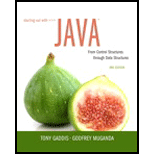
First to One Game
This game is meant for two or more players. In the game, each player starts out with 50 points, as each player takes a turn rolling the dice; the amount generated by the dice is subtracted from the player’s points. The first player with exactly one point remaining wins. If a player’s remaining points minus the amount generated by the dice results in a value less than one, then the amount should he added to the player’s points. (As an alternative, the game can be played with a set number turns. In this case, the player with the amount of points closest to one, when all rounds have been played, wins.)
Write a program that simulates the game being played by two players. Use the Die class that was presented in Chapter 6 to simulate the dice. Write a Player class to simulate the players.
Want to see the full answer?
Check out a sample textbook solution
Chapter 8 Solutions
Starting Out with Java: From Control Structures through Data Structures (3rd Edition)
Additional Engineering Textbook Solutions
Starting Out with C++: Early Objects (9th Edition)
Database Concepts (8th Edition)
BASIC BIOMECHANICS
Computer Science: An Overview (13th Edition) (What's New in Computer Science)
Concepts Of Programming Languages
Starting Out with C++ from Control Structures to Objects (9th Edition)
 C++ Programming: From Problem Analysis to Program...Computer ScienceISBN:9781337102087Author:D. S. MalikPublisher:Cengage Learning
C++ Programming: From Problem Analysis to Program...Computer ScienceISBN:9781337102087Author:D. S. MalikPublisher:Cengage Learning C++ for Engineers and ScientistsComputer ScienceISBN:9781133187844Author:Bronson, Gary J.Publisher:Course Technology Ptr
C++ for Engineers and ScientistsComputer ScienceISBN:9781133187844Author:Bronson, Gary J.Publisher:Course Technology Ptr EBK JAVA PROGRAMMINGComputer ScienceISBN:9781337671385Author:FARRELLPublisher:CENGAGE LEARNING - CONSIGNMENT
EBK JAVA PROGRAMMINGComputer ScienceISBN:9781337671385Author:FARRELLPublisher:CENGAGE LEARNING - CONSIGNMENT EBK JAVA PROGRAMMINGComputer ScienceISBN:9781305480537Author:FARRELLPublisher:CENGAGE LEARNING - CONSIGNMENTProgramming Logic & Design ComprehensiveComputer ScienceISBN:9781337669405Author:FARRELLPublisher:Cengage
EBK JAVA PROGRAMMINGComputer ScienceISBN:9781305480537Author:FARRELLPublisher:CENGAGE LEARNING - CONSIGNMENTProgramming Logic & Design ComprehensiveComputer ScienceISBN:9781337669405Author:FARRELLPublisher:Cengage Microsoft Visual C#Computer ScienceISBN:9781337102100Author:Joyce, Farrell.Publisher:Cengage Learning,
Microsoft Visual C#Computer ScienceISBN:9781337102100Author:Joyce, Farrell.Publisher:Cengage Learning,





